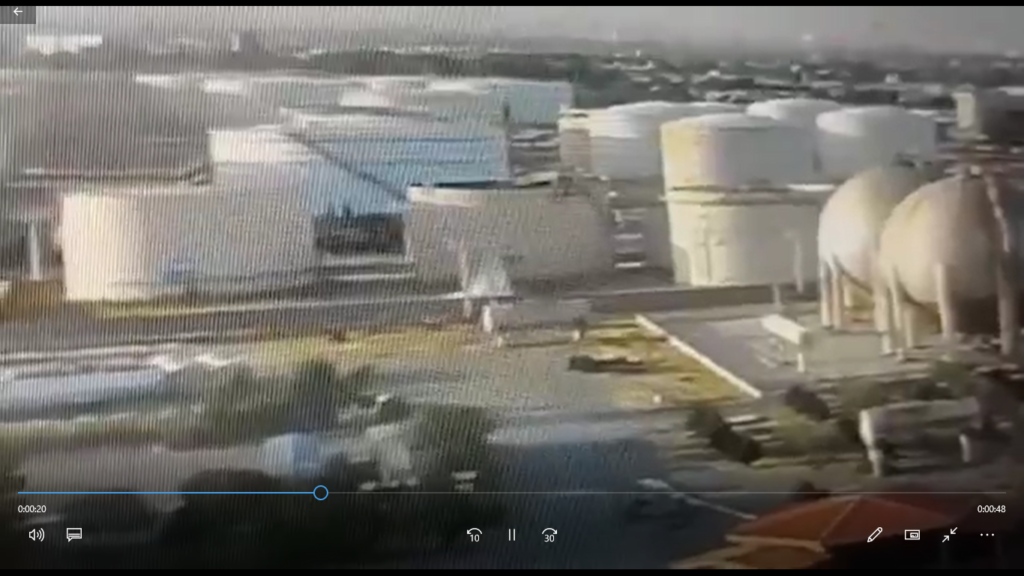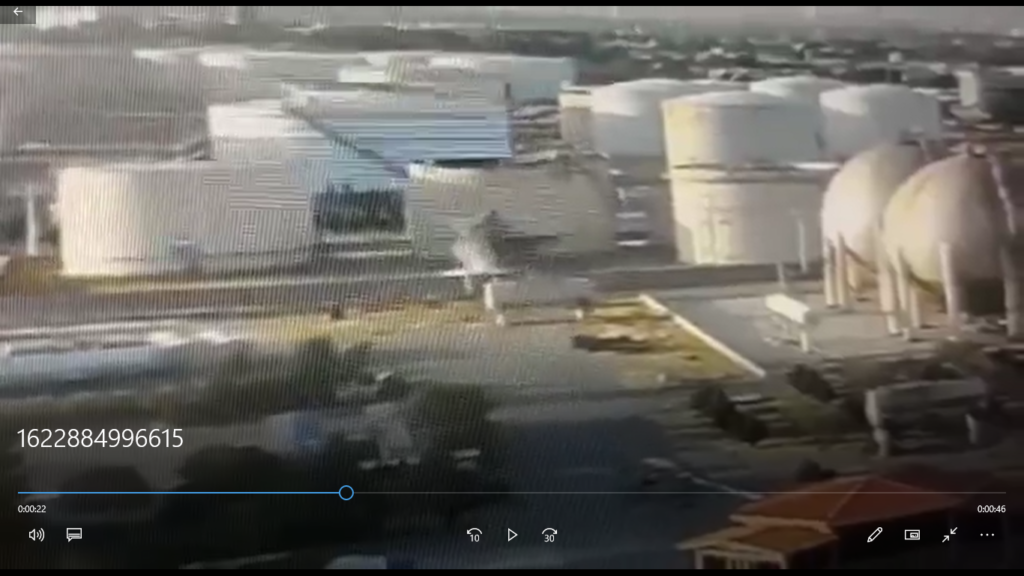In the news. Analyzing tank failure in an Oil refinery.
In wednesday 2, June 2021, a fire erupted at the state-owned Tondgooyan Petrochemical Co. to the south of Tehran. The Oil Ministry’s SHANA news agency said it was caused by a leak in two waste tanks at the facility. Authorities initially suggested the flames affected a liquified petroleum gas pipeline at the refinery. (Source)
The objective of this post is to shed some light in which could be the causes of the failure in the tank. I want to risk my opinion on this accident because I want to clarify some things that have been said. Also it is an unique opportunity because not every day you see video footage of a tank failure so clearly.
I don´t claim to have the truth in this case, but I will tell my conclusions anyway.
Before reading the next lines, please check the video below.
The tank is an external floating roof tank type with rolling ladder. It is atmospheric.
What was the cause for this mess? The comments in linkedin were many and varied. Very respected engineers said that it was a lack of third party inspection. A big portion of the comments said that it was lack of maintenance. Still others said that the thank was just too old to be still in service.
How could this people come to such different conclusions? Let´s see some possible explanations.
BRITTLE FRACURE. Ambient temperatures in Iran in May are not so cold. This reduces the possibility of brittle failure. However, we cannot discard it as a cause.
TANK AGE. Tank age could have something to do, because throught the years, the tank corrodes in several parts and loses capacity. However, a tank can be suitable for the same service eternally, in theory, if it is inspected with a correct frequency, repainted and protected by a cathodic protection system. I don´t know about the Iranian construction standard, but I don´t think there is any part of it that limits the age of a tank.
REGULAR NDT AND INSPECTION. I assume that the tank had an inspection in the last 10 years. This would reduce the chance of corrosion defects in the inside of the weld. Regarding NDT, the following question arises. Should we conduct 100% NDT over horizontal welds every now and then? It is difficult to conduct NDT over an horizontal weld, because it would be prohibitively expensive. If the tank failed because of lack of ULTRASONIC inspection of the horizontal weld, then we are all doomed, because that would mean that we need to stop the operation of every tank around the world right now just to make sure that the horizontal weld is safe.
No. The best option is to trust the construction proccess and the construction records, which is the tricky part. A tank´s construction proccess involves the making of an hydrostatic test that proves that the equipment will operate for the intended service and level. But because of the high cost of the test, sometimes the contractor will try to avoid it or make it with less water, recording a higher level in the reports than it was actually made.
In this case, the clues to the solution of the mistery are in the video itself.
Let´s check some of the frames of the video.
00:06. Lack of contention can be seen. The pattern implies and failure mode that is horizontal

00:20. The Flow increases

00:22 The horizontal Weld unzips

00:26 There is a spark at the top of the Shell inf the left side, which coincides with the top of the inclined floating roof

This is what I think happeneD.
1. The tank failed at the maximum level. This is evident in the position of the rolling ladder, way up. That is bad operation and one of the main reasons of this accident. Maybe there was a mechanical problem with the valves or the level measuring device, or the operator just forgot.
2. Also, there must have been poor workmanship during construction, because it is not expected that the horizontal weld fails rather than the vertical. This signals to several possible mistakes that an on-site investigator should be able to pinpoint. You can see that there is an horizontal attachment to the shell (Unless, of course, that there is corrosion in an horizontal plane, be it at the weld or at the shell). Maybe it was welded without respecting the distances. This added to the fact that maybe there was a change of service to a more severe service without a torough analysis, or maybe the hydrostatic test wasn´t performed correctly or at all. The hydrostatic test reduces the risk of failures during change of service also.
We don´t know. But it is evident that someone did a bad job.
3. Lastly, the spark generated because the roof, I would bet, was not grounded to the rest of the tank and to the terrain, generating a difference of voltage between the roof and shell. Sparks by electric cables are another possibility. A good grounding system is an additional protection layer for a tank, because even if it fails catastrophically, there could be no fire.
I don´t think bad inspection is to blame. Usually there isn´t any information and nobody knows nothing of nothing about they equipment work with on a daily basis. In conclusion, as with any other accident, the overall integrity program and IOW program failed.
AFTERMATH OF THE INCIDENT
What are the implications of this for the Tehran Oil refinery? Well, this implies that operation personnel must be trained again in the risk associated with old tanks. A portion of the risk in a tank is due to the lack of information or information fraud.
This also implies that inspection plans for all of the tanks in this facility (or at least by the same contractor or made in close dates) must include from now on a percentage of inspection of the horizontal welds of the tanks, which is not common during normal inspections. The revision should include all the tanks built BY THE SAME CONTRACTOR. This NDT requirement is only because foul-play is suspected.
Operator, owners and inspectors around the world must keep construction, maintenance, repair and inspection records up to date. Also it is neccesary that from now on operations personnel take inpsection duties, which they don´t like. They must be trained in the use and inspection of protective measures for tanks. This includes lightning and electrical discharge protection. Usually, operators, inspectors and maintenance personnel don´t work together.
I have seen some recent headlines informing about how the new construction standards allow for the exception of the hydrostatic test. I can understand this, because technologies are advancing very fast. You can, in theory, control all of the variables during a construction proccess for many tanks, keep them the same and test just one hydrostatically, and extend the test conclusion for the others. But this was not the case 10, 20 or 30 years ago.
The best option is to keep a good integrity program which includes an IOW program so this accidents don´t happen so often.
IF YOU WANT TO KNOW MORE ABOUT A COURSE TO PASS THE API 653 INSPECTION EXAM, CLICK HERE
Regards.
Carlos Molina
Leave a Comment